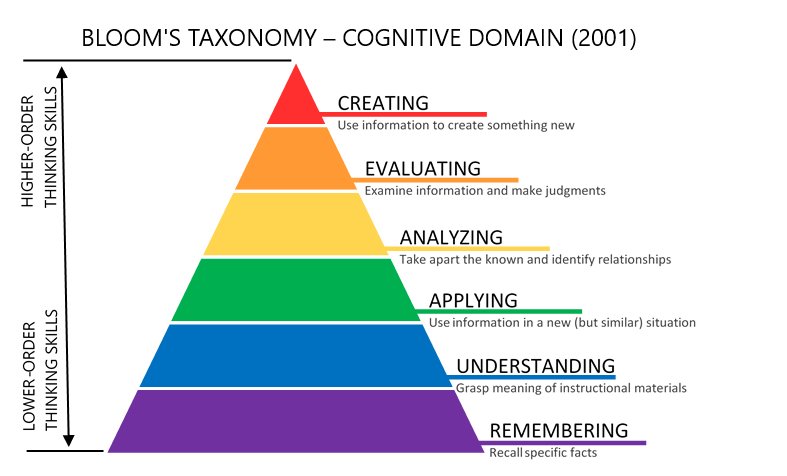Bloom's taxonomy
Bloom's Taxonomy, initially introduced by Benjamin Bloom in 1956, has been widely adopted as a framework for categorising educational goals. Revised to promote more dynamic learning objectives, it outlines a range of cognitive skills from basic recall to complex analytical and creative tasks. This guide provides learning designers with an understanding of the taxonomy's structure and practical applications for course design.
Levels of cognitive skills
Bloom's Taxonomy organises learning objectives into six hierarchical levels, each requiring a deeper cognitive engagement:
-
Remembering: Retrieving knowledge from long-term memory.
- Verbs: List, Describe, Name, Identify
- Application: Learners could be asked to list the main events of a historical battle.
-
Understanding: Constructing meaning from instructional messages.
- Verbs: Explain, Summarise, Paraphrase, Classify
- Application: Learners might summarise the key points of a research article.
-
Applying: Using procedures in a given situation.
- Verbs: Use, Implement, Execute
- Application: Learners could use a mathematical formula to solve a real-world problem.
-
Analysing: Breaking material into parts to understand its structure.
- Verbs: Analyse, Differentiate, Compare
- Application: Learners might compare two philosophical theories to evaluate their effectiveness.
-
Evaluating: Making judgments based on criteria and standards.
- Verbs: Evaluate, Critique, Judge
- Application: Learners could critique a piece of artwork based on established criteria.
-
Creating: Putting elements together to form a coherent or functional whole.
- Verbs: Create, Design, Construct
- Application: Learners might design a marketing strategy for a new product.
 https://citt.ufl.edu/resources/the-learning-process/designing-the-learning-experience/blooms-taxonomy/blooms-taxonomy-graphic-description/
https://citt.ufl.edu/resources/the-learning-process/designing-the-learning-experience/blooms-taxonomy/blooms-taxonomy-graphic-description/
Implementing Bloom's taxonomy in course design
integrating Bloom's Taxonomy into course design and course mapping helps create a structured and effective learning environment that systematically enhances cognitive engagement and ensures that all course components – objectives, content, assessments, and instructional methods – are cohesively aligned to support student learning and achievement
When designing a course map, consider the following steps to effectively incorporate Bloom's Taxonomy:
- Align Objectives with Educational Goals: Ensure that learning objectives at each level of the taxonomy align with the overall educational goals of the course.
- Progressive Complexity: Design course content to progressively challenge learners, starting from basic recall tasks to more complex analysis and creation tasks.
- Assessment Strategies: Develop assessments that appropriately evaluate learning at each taxonomy level. Remembering and understanding might be assessed through multiple-choice questions while creating and evaluating might require essays or projects.
- Instructional Methods: Choose teaching methods that foster the desired level of cognitive engagement. Interactive discussions, problem-solving sessions, and group projects are effective for higher levels of cognition.
Benefits of using Bloom's taxonomy
- Enhanced Course Structure: Provides a clear roadmap for course development, ensuring a balanced approach to teaching and learning.
- Improved Learning Outcomes: Encourages diverse cognitive activities, helping learners develop higher-order thinking skills.
- Clearer Assessment Criteria: Facilitates the creation of assessment rubrics that align with learning objectives, ensuring more precise evaluation of student performance.
NZQF and Bloom's
Integrating higher levels of Bloom's taxonomy across all NZQF levels can enhance the depth and breadth of learning experiences by encouraging critical thinking and advanced cognitive skills from the outset. Here’s how this can be systematically implemented:
Progressive Cognitive Development
At the foundational NZQF Levels 1-3, traditionally associated with remembering, understanding, and applying, educators can introduce verbs from higher Bloom's categories like "analyse" or "evaluate." However, the complexity of the tasks associated with these verbs would be moderated to suit the introductory level. For instance, analysing at level 1 might involve using direct comparisons between two elements with guided questions, ensuring that the task remains achievable and clearly defined for beginners.
Moving to NZQF Levels 4-6, where applying, analysing, and evaluating are more commonly targeted, educators can increase the complexity of tasks requiring these cognitive skills. Here, "evaluate" might involve critiquing a set methodology or theory based on a structured set of criteria provided in the coursework, moving beyond simple comparisons to more nuanced discussions that require justification of viewpoints.
At the advanced NZQF Levels 7-10, learners are expected to engage deeply with creating and evaluating, demonstrating mastery over their subject matter. Here, the use of high-level verbs becomes more sophisticated, involving the creation of new theories or models and the critical evaluation of complex systems without the scaffolding provided at lower levels. The tasks require a high degree of autonomy and sophisticated critical thinking.
Curriculum Design Considerations
Curriculum Alignment: Each level should carefully build upon the previous one, ensuring that students develop a solid foundation in lower levels that supports the understanding and skills needed for higher-level cognitive tasks. The curriculum should progressively introduce more complexity in the tasks and greater independence in learning.
Assessment Design: Assessments should be aligned with the expected cognitive skills at each level. While higher-order tasks might be introduced early, the complexity and depth of assessment criteria should correspond to the NZQF level, ensuring that students are evaluated fairly according to their stage of educational development.
Support Mechanisms: To support this integrated approach, we should provide ample resources such as tutorials, example, and access to guidance. This support is crucial in the lower levels to ensure that students understand how to approach more complex cognitive tasks.
